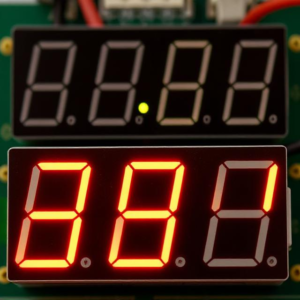What are Alphanumeric Displays?
Alphanumeric displays are screens or devices that show both letters (A-Z) and numbers (0-9), along with sometimes special characters like punctuation marks or symbols. They’re called “alphanumeric” because they can display a combination of alphabetic characters and numeric digits.

Types of Alphanumeric Displays
- 7-Segment Display:
- This is one of the most common types of alphanumeric displays.
- It has 7 individual segments (small LED lights) arranged in a figure-8 shape. By turning on or off different segments, it can display numbers and some letters. For example, it can show the number “5” or the letter “A” by lighting up the right segments.
- 7-segment displays are commonly seen in clocks, calculators, and other simple devices that show numbers or letters.
- Dot Matrix Display:
- A dot matrix display is made up of a grid of small dots (LEDs or pixels). Each dot can be turned on or off to create different shapes, letters, and numbers.
- Since it’s a grid, it can show more complex characters and even images or logos.
- These displays are used in things like signboards, digital clocks, or small screens on electronics where you need more flexibility in what can be displayed.
How Do Alphanumeric Displays Work?
- 7-Segment Display:
- Each digit is made up of 7 segments that can light up in different combinations. For example, to show the number “8”, all 7 segments are lit up. To show the letter “A”, a different set of segments lights up.
- The 7 segments are arranged in a specific pattern, and by turning the right segments on or off, the display shows the desired character.
- Dot Matrix Display:
- The grid of dots in a dot matrix display allows more freedom because you can control each dot individually.
- For example, to show a letter “B”, the system can light up a series of dots in the shape of a “B” in the grid.
- These displays are typically controlled by a microcontroller or driver that decides which dots to light up.
Why Are Alphanumeric Displays Useful?
- Versatility: Alphanumeric displays can show both numbers and letters, which makes them useful in a wide variety of applications, from digital clocks to electronic signs.
- Readability: They’re easy to read, especially in low-light environments when using LED technology, making them useful in public spaces, devices, and appliances.
- Cost-Effective: 7-segment displays, in particular, are inexpensive to produce and are widely used in things like calculators, car dashboards, and home appliances.
Where Are They Used?
- Digital Clocks: The time is often shown on a 7-segment display or a dot matrix display.
- Calculators: Most calculators use 7-segment displays to show numbers and some simple letters.
- Electronic Signboards: Bus stops, train stations, and sports stadiums use large dot matrix displays to show text and numbers.
- Appliances: Devices like microwaves, washing machines, and air conditioners often use alphanumeric displays to show settings, times, and temperatures.
- Toys and Gadgets: Simple toys or gadgets may use these displays to show information in a fun or functional way.
Pros of Alphanumeric Displays
- Clear and Easy to Read: These displays are designed to show text or numbers in a way that’s easy to read, even from a distance.
- Simple to Use: Alphanumeric displays are often used in simple, low-cost devices. They don’t require complicated systems to display information.
- Versatile: They can show a wide range of characters, making them useful for both numbers and letters.
Cons of Alphanumeric Displays
- Limited Graphics: Compared to full-color screens (like in smartphones), alphanumeric displays can only show limited characters or shapes. They can’t show complex images or detailed graphics.
- Smaller Display: Most alphanumeric displays are small, so they might not be ideal for showing large amounts of information at once.
Summary
Alphanumeric displays are screens that can show both numbers and letters. The most common types are 7-segment displays, which use 7 segments to form numbers and letters, and dot matrix displays, which have a grid of dots to form more complex shapes. These displays are everywhere, from clocks to calculators to signs, and they’re popular because they’re simple, clear, and versatile.











